harmony 鸿蒙\@Observed and \@ObjectLink Decorators: Observing Property Changes in Nested Class Objects
\@Observed and \@ObjectLink Decorators: Observing Property Changes in Nested Class Objects
The decorators including \@State, \@Prop, \@Link, \@Provide and \@Consume can only observe the top-layer changes. However, in actual application development, the application encapsulates its own data model based on the requirements. In this case, for multi-layer nesting, for example, a two-dimensional array, an array item class, or a class inside another class as a property, the property changes at the second layer cannot be observed. This is where the \@Observed and \@ObjectLink decorators come in handy.
\@Observed and \@ObjectLink are used together to observe nested scenarios, aiming at offsetting the limitation that the decorator can observe only one layer. You are advised to have a basic understanding of the observation capability of the decorators before reading this topic. For details, see \@State.
NOTE
These two decorators can be used in ArkTS widgets since API version 9.
These two decorators can be used in atomic services since API version 11.
Overview
\@ObjectLink and \@Observed class decorators are used for two-way data synchronization in scenarios involving nested objects or arrays:
Use new to create a class decorated by \@Observed so that the property changes can be observed.
The \@ObjectLink decorated state variable in the child component is used to accept the instance of the \@Observed decorated class and establish two-way data binding with the corresponding state variable in the parent component. The instance can be an \@Observed decorated item in the array or an \@Observed decorated property in the class object.
Using \@Observed alone has no effect in nested classes. To observe changes of class properties, it must be used with a custom component. (For examples, see Nested Object). To create a two-way or one-way synchronization, it must be used with \@ObjectLink or with \@Prop. (For details, see Differences Between \@Prop and \@ObjectLink.)
Decorator Description
| \@Observed Decorator | Description |
|---|---|
| Decorator parameters | None. |
| Class decorator | Decorates a class. You must use new to create a class object before defining the class. |
| \@ObjectLink Decorator | Description |
|---|---|
| Decorator parameters | None. |
| Allowed variable types | In versions earlier than API version 18, @ObjectLink must be initialized with an \@Observed decorated class instance. Since API version 18, \@ObjectLink can also be initialized with the return value of makeV1Observed. \@ObjectLink does not support simple types. To use simple types, you can use \@Prop. It supports class instances that inherit from Date, Array, Map, and Set (the latter two are supported since API version 11). For an example, see Observed Changes. Since API version 11, @ObjectLink supports union types of @Observed decorated classes and undefined or null, for example, ClassA |ClassB, ClassA |undefined, or ClassA |null. For details, see Union Type @ObjectLink. An @ObjectLink decorated variable accepts changes to its properties, but the variable itself is read-only. |
| Initial value for the decorated variable | Not allowed. |
Example of a read-only \@ObjectLink decorated variable:
// Allowed: assigning a value to a property of an @ObjectLink decorated variable
this.objLink.a= ...
// Not allowed: assigning a new value to the @ObjectLink decorated variable itself
this.objLink= ...
NOTE
Value assignment is not allowed for the \@ObjectLink decorated variable. To assign a value, use @Prop instead.
\@Prop creates a one-way synchronization from the data source to the decorated variable. It takes a copy of its source to enable changes to remain local. When \@Prop observes a change to its source, the local value of the \@Prop decorated variable is overwritten.
\@ObjectLink creates a two-way synchronization between the data source and the decorated variable. An \@ObjectLink decorated variable can be considered as a pointer to the source object inside the parent component. Do not assign values to \@ObjectLink decorated variables, as doing so will interrupt the synchronization chain. \@ObjectLink decorated variables are initialized through data source (Object) references. Assigning a value to them is equivalent to updating the array items or class properties in the parent component, which is not supported in TypeScript/JavaScript and will result in a runtime error.
Variable Transfer/Access Rules
| \@ObjectLink Transfer/Access | Description |
|---|---|
| Initialization from the parent component | Mandatory. To initialize an \@ObjectLink decorated variable, a variable in the parent component must meet all the following conditions: - The variable type is an \@Observed decorated class. - The initialized value must be an array item or a class property. - The class or array of the synchronization source must be decorated by \@State, \@Link, \@Provide, \@Consume, or \@ObjectLink. For an example where the synchronization source is an array item, see Object Array. For an example of the initialized class, see Nested Object. |
| Synchronization with the source | Two-way. |
| Subnode initialization | Supported; can be used to initialize a regular variable or \@State, \@Link, \@Prop, or \@Provide decorated variable in the child component. |
Figure 1 Initialization rule
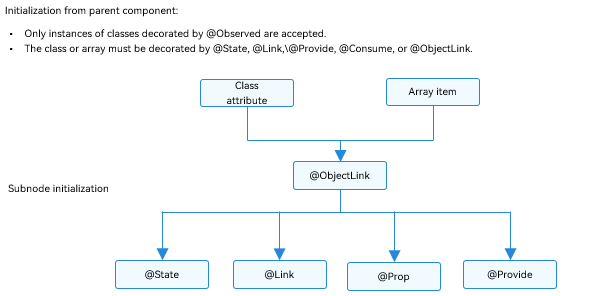
Observed Changes and Behavior
Observed Changes
If the property of an \@Observed decorated class is not of the simple type, such as class, object, or array, it must be decorated by \@Observed. Otherwise, the property changes cannot be observed.
class Child {
public num: number;
constructor(num: number) {
this.num = num;
}
}
@Observed
class Parent {
public child: Child;
public count: number;
constructor(child: Child, count: number) {
this.child = child;
this.count = count;
}
}
In the preceding example, Parent is decorated by \@Observed, and the value changes of its member variables can be observed. In contrast, Child is not decorated by \@Observed, and therefore its property changes cannot be observed.
@ObjectLink parent: Parent;
// Value changes can be observed.
this.parent.child = new Child(5);
this.parent.count = 5;
// Child is not decorated by @Observed, therefore, its property changes cannot be observed.
this.parent.child.num = 5;
\@ObjectLink: \@ObjectLink can only accept instances of classes decorated by \@Observed. When possible, design a separate custom component to render each array or object. In this case, an object array or nested object (which is an object whose property is an object) requires two custom components: one for rendering an external array/object, and the other for rendering a class object nested within the array/object. The following can be observed:
Value changes of the properties that Object.keys(observedObject) returns. For details, see Nested Object.
Replacement of array items for the data source of an array and changes of class properties for the data source of a class. For details, see Object Array.
For an instance of the class that extends Date, the value changes of Date properties can be observed. In addition, you can call the following APIs to update Date properties: setFullYear, setMonth, setDate, setHours, setMinutes, setSeconds, setMilliseconds, setTime, setUTCFullYear, setUTCMonth, setUTCDate, setUTCHours, setUTCMinutes, setUTCSeconds, and setUTCMilliseconds.
@Observed
class DateClass extends Date {
constructor(args: number|string) {
super(args);
}
}
@Observed
class NewDate {
public data: DateClass;
constructor(data: DateClass) {
this.data = data;
}
}
@Component
struct Child {
label: string = 'date';
@ObjectLink data: DateClass;
build() {
Column() {
Button(`child increase the day by 1`)
.onClick(() => {
this.data.setDate(this.data.getDate() + 1);
})
DatePicker({
start: new Date('1970-1-1'),
end: new Date('2100-1-1'),
selected: this.data
})
}
}
}
@Entry
@Component
struct Parent {
@State newData: NewDate = new NewDate(new DateClass('2023-1-1'));
build() {
Column() {
Child({ label: 'date', data: this.newData.data })
Button(`parent update the new date`)
.onClick(() => {
this.newData.data = new DateClass('2023-07-07');
})
Button(`ViewB: this.newData = new NewDate(new DateClass('2023-08-20'))`)
.onClick(() => {
this.newData = new NewDate(new DateClass('2023-08-20'));
})
}
}
}
For a class that extends Map, the value changes of the Map instance can be observed. In addition, you can call the following APIs to update the instance: set, clear, and delete. For details, see Extended Map Class.
For a class that extends Set, the value changes of the Set instance can be observed. In addition, you can call the following APIs to update the instance: add, clear, and delete. For details, see Extended Set Class.
Framework Behavior
- Initial rendering:
a. \@Observed causes all instances of the decorated class to be wrapped with an opaque proxy object, which takes over the setter and getter methods of the properties of the class.
b. The \@ObjectLink decorated variable in the child component is initialized from the parent component and accepts the instance of the \@Observed decorated class. The \@ObjectLink decorated wrapped object registers itself with the \@Observed decorated class.
- Property update: When the property of the \@Observed decorated class is updated, the framework executes setter and getter methods of the proxy, traverses the \@ObjectLink decorated wrapped objects that depend on it, and notifies the data update.
Constraints
Using \@Observed to decorate a class changes the original prototype chain of the class. Using \@Observed and other class decorators to decorate the same class may cause problems.
The \@ObjectLink decorator cannot be used in custom components decorated by \@Entry.
The \@ObjectLink decorator must be used with complex types. Otherwise, an error is reported during compilation.
In versions earlier than API version 18, the type of the variable decorated by \@ObjectLink must be a class explicitly decorated by @Observed. If the type is not specified or is not a class decorated by \@Observed, an error is reported during compilation. Since API version 18, \@ObjectLink can also be initialized with the return value of makeV1Observed. If it is not properly initialized, an error is reported during runtime.
@Observed
class Info {
count: number;
constructor(count: number) {
this.count = count;
}
}
class Test {
msg: number;
constructor(msg: number) {
this.msg = msg;
}
}
// Incorrect format. The count type is not specified, leading to a compilation error.
@ObjectLink count;
// Incorrect format. Test is not decorated by @Observed, leading to a compilation error.
@ObjectLink test: Test;
// Correct format.
@ObjectLink count: Info;
- Variables decorated by \@ObjectLink cannot be initialized locally. You can only pass in the initial value from the parent component through construction parameters. Otherwise, an error is reported during compilation.
@Observed
class Info {
count: number;
constructor(count: number) {
this.count = count;
}
}
// Incorrect format. An error is reported during compilation.
@ObjectLink count: Info = new Info(10);
// Correct format.
@ObjectLink count: Info;
- The variables decorated by \@ObjectLink are read-only and cannot be assigned values. Otherwise, an error “Cannot set property when setter is undefined” is reported during runtime. If you need to replace all variables decorated by \@ObjectLink, you can replace them in the parent component.
[Incorrect Usage]
@Observed
class Info {
count: number;
constructor(count: number) {
this.count = count;
}
}
@Component
struct Child {
@ObjectLink num: Info;
build() {
Column() {
Text(`Value of num: ${this.num.count}`)
.onClick(() => {
// Incorrect format. The variable decorated by @ObjectLink cannot be assigned a value.
this.num = new Info(10);
})
}
}
}
@Entry
@Component
struct Parent {
@State num: Info = new Info(10);
build() {
Column() {
Text(`Value of count: ${this.num.count}`)
Child({num: this.num})
}
}
}
[Correct Usage]
@Observed
class Info {
count: number;
constructor(count: number) {
this.count = count;
}
}
@Component
struct Child {
@ObjectLink num: Info;
build() {
Column() {
Text(`Value of num: ${this.num.count}`)
.onClick(() => {
// Correct format, which is used to change the member property of the @ObjectLink decorated variables.
this.num.count = 20;
})
}
}
}
@Entry
@Component
struct Parent {
@State num: Info = new Info(10);
build() {
Column() {
Text(`Value of count: ${this.num.count}`)
Button('click')
.onClick(() => {
// Replace the variable in the parent component.
this.num = new Info(30);
})
Child({num: this.num})
}
}
}
Use Scenarios
Inheritance Object
@Observed
class Animal {
name: string;
age: number;
constructor(name: string, age: number) {
this.name = name;
this.age = age;
}
}
@Observed
class Dog extends Animal {
kinds: string;
constructor(name: string, age: number, kinds: string) {
super(name, age);
this.kinds = kinds;
}
}
@Entry
@Component
struct Index {
@State dog: Dog = new Dog('Molly', 2, 'Husky');
@Styles
pressedStyles() {
.backgroundColor('#ffd5d5d5')
}
@Styles
normalStyles() {
.backgroundColor('#ffffff')
}
build() {
Column() {
Text(`${this.dog.name}`)
.width(320)
.margin(10)
.fontSize(30)
.textAlign(TextAlign.Center)
.stateStyles({
pressed: this.pressedStyles,
normal: this.normalStyles
})
.onClick(() => {
this.dog.name = 'DouDou';
})
Text(`${this.dog.age}`)
.width(320)
.margin(10)
.fontSize(30)
.textAlign(TextAlign.Center)
.stateStyles({
pressed: this.pressedStyles,
normal: this.normalStyles
})
.onClick(() => {
this.dog.age = 3;
})
Text(`${this.dog.kinds}`)
.width(320)
.margin(10)
.fontSize(30)
.textAlign(TextAlign.Center)
.stateStyles({
pressed: this.pressedStyles,
normal: this.normalStyles
})
.onClick(() => {
this.dog.kinds = 'Samoyed';
})
}
}
}

In the preceding example, some properties (name and age) in the Dog class are inherited from the Animal class. You can directly change name and age in the dog variable decorated by \@State to trigger UI re-rendering.
Nested Object
@Observed
class Book {
name: string;
constructor(name: string) {
this.name = name;
}
}
@Observed
class Bag {
book: Book;
constructor(book: Book) {
this.book = book;
}
}
@Component
struct BookCard {
@ObjectLink book: Book;
build() {
Column() {
Text(`BookCard: ${this.book.name}`) // The name change can be observed.
.width(320)
.margin(10)
.textAlign(TextAlign.Center)
Button('change book.name')
.width(320)
.margin(10)
.onClick(() => {
this.book.name = 'C++';
})
}
}
}
@Entry
@Component
struct Index {
@State bag: Bag = new Bag(new Book('JS'));
build() {
Column() {
Text(`Index: ${this.bag.book.name}`) // The name change cannot be observed.
.width(320)
.margin(10)
.textAlign(TextAlign.Center)
Button('change bag.book.name')
.width(320)
.margin(10)
.onClick(() => {
this.bag.book.name = 'TS';
})
BookCard({ book: this.bag.book })
}
}
}
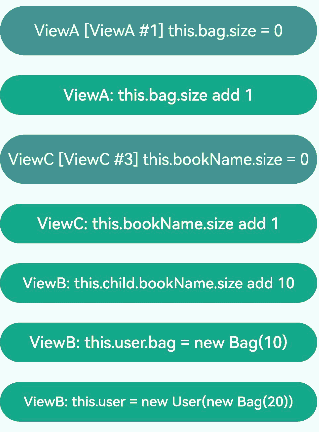
In the preceding example, the Text component in the Index component is not re-rendered because the change belongs to the second layer and \@State cannot observe the change at the second layer. However, Book is decorated by \@Observed, and the name property of Book can be observed by \@ObjectLink. Therefore, no matter which button is clicked, the Text component in the BookCard component is re-rendered.
Object Array
An object array is a frequently used data structure. The following example shows the usage of array objects.
NOTE
NextID is used to generate a unique, persistent key for each array item during ForEach rendering to identify the corresponding component.
let NextID: number = 1;
@Observed
class Info {
public id: number;
public info: number;
constructor(info: number) {
this.id = NextID++;
this.info = info;
}
}
@Component
struct Child {
// The type of the Child's @ObjectLink is Info.
@ObjectLink info: Info;
label: string = 'ViewChild';
build() {
Row() {
Button(`ViewChild [${this.label}] this.info.info = ${this.info ? this.info.info : "undefined"}`)
.width(320)
.margin(10)
.onClick(() => {
this.info.info += 1;
})
}
}
}
@Entry
@Component
struct Parent {
// Info[] decorated by @State in the Parent.
@State arrA: Info[] = [new Info(0), new Info(0)];
build() {
Column() {
ForEach(this.arrA,
(item: Info) => {
Child({ label: `#${item.id}`, info: item })
},
(item: Info): string => item.id.toString()
)
// Initialize the @ObjectLink decorated variable using the @State decorated array, whose items are instances of @Observed decorated Info.
Child({ label: `ViewChild this.arrA[first]`, info: this.arrA[0] })
Child({ label: `ViewChild this.arrA[last]`, info: this.arrA[this.arrA.length-1] })
Button(`ViewParent: reset array`)
.width(320)
.margin(10)
.onClick(() => {
this.arrA = [new Info(0), new Info(0)];
})
Button(`ViewParent: push`)
.width(320)
.margin(10)
.onClick(() => {
this.arrA.push(new Info(0));
})
Button(`ViewParent: shift`)
.width(320)
.margin(10)
.onClick(() => {
if (this.arrA.length > 0) {
this.arrA.shift();
} else {
console.log("length <= 0");
}
})
Button(`ViewParent: item property in middle`)
.width(320)
.margin(10)
.onClick(() => {
this.arrA[Math.floor(this.arrA.length / 2)].info = 10;
})
Button(`ViewParent: item property in middle`)
.width(320)
.margin(10)
.onClick(() => {
this.arrA[Math.floor(this.arrA.length / 2)] = new Info(11);
})
}
}
}
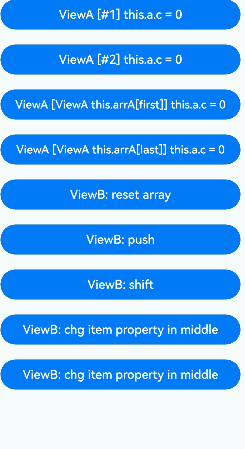
this.arrA[Math.floor(this.arrA.length/2)] = new Info(..): The change of this state variable triggers two updates.
- ForEach: The value assignment of the array item causes the change of itemGenerator of ForEach. Therefore, the array item is identified as changed, and the item builder of ForEach is executed to create a Child component instance.
- Child({ label: ViewChild this.arrA[last], info: this.arrA[this.arrA.length-1] }): The preceding update changes the second element in the array. Therefore, the Child component instance bound to this.arrA[1] is updated.
this.arrA.push(new Info(0)): The change of this state variable triggers two updates with different effects.
- ForEach: The newly added Info object is unknown to the ForEach itemGenerator. The item builder of ForEach will be executed to create a Child component instance.
- Child({ label: ViewChild this.arrA[last], info: this.arrA[this.arrA.length-1] }): The last item of the array is changed. As a result, the second Child component instance is changed. Child({ label: ViewChild this.arrA[first], info: this.arrA[0] }): The change to the array does not trigger a change to the array item, so the first Child component instance is not re-rendered.
this.arrA[Math.floor(this.arrA.length/2)].info: @State cannot observe changes at the second layer. However, as Info is decorated by \@Observed, the change of its properties will be observed by \@ObjectLink.
Two-Dimensional Array
@Observed class decoration is required for a two-dimensional array. You can declare an \@Observed decorated class that extends from Array.
@Observed
class ObservedArray<T> extends Array<T> {
}
Declare a class ObservedArray<T> inherited from Array and use new to create an instance of ObservedArray<string>, and then the property changes can be observed.
The following example shows how to use \@Observed to observe the changes of a two-dimensional array.
@Observed
class ObservedArray<T> extends Array<T> {
}
@Component
struct Item {
@ObjectLink itemArr: ObservedArray<string>;
build() {
Row() {
ForEach(this.itemArr, (item: string, index: number) => {
Text(`${index}: ${item}`)
.width(100)
.height(100)
}, (item: string) => item)
}
}
}
@Entry
@Component
struct IndexPage {
@State arr: Array<ObservedArray<string>> = [new ObservedArray<string>('apple'), new ObservedArray<string>('banana'), new ObservedArray<string>('orange')];
build() {
Column() {
ForEach(this.arr, (itemArr: ObservedArray<string>) => {
Item({ itemArr: itemArr })
})
Divider()
Button('push two-dimensional array item')
.margin(10)
.onClick(() => {
this.arr[0].push('strawberry');
})
Button('push array item')
.margin(10)
.onClick(() => {
this.arr.push(new ObservedArray<string>('pear'));
})
Button('change two-dimensional array first item')
.margin(10)
.onClick(() => {
this.arr[0][0] = 'APPLE';
})
Button('change array first item')
.margin(10)
.onClick(() => {
this.arr[0] = new ObservedArray<string>('watermelon');
})
}
}
}
Since API version 18, \@ObjectLink can also be initialized with the return value of makeV1Observed. Therefore, if you do not want to declare the class that inherits from array, you can use makeV1Observed to achieve the same effect.
A complete example is as follows:
import { UIUtils } from '@kit.ArkUI';
@Component
struct Item {
@ObjectLink itemArr: Array<string>;
build() {
Row() {
ForEach(this.itemArr, (item: string, index: number) => {
Text(`${index}: ${item}`)
.width(100)
.height(100)
}, (item: string) => item)
}
}
}
@Entry
@Component
struct IndexPage {
@State arr: Array<Array<string>> =
[UIUtils.makeV1Observed(['apple']), UIUtils.makeV1Observed(['banana']), UIUtils.makeV1Observed(['orange'])];
build() {
Column() {
ForEach(this.arr, (itemArr: Array<string>) => {
Item({ itemArr: itemArr })
})
Divider()
Button('push two-dimensional array item')
.margin(10)
.onClick(() => {
this.arr[0].push('strawberry');
})
Button('push array item')
.margin(10)
.onClick(() => {
this.arr.push(UIUtils.makeV1Observed(['pear']));
})
Button('change two-dimensional array first item')
.margin(10)
.onClick(() => {
this.arr[0][0] = 'APPLE';
})
Button('change array first item')
.margin(10)
.onClick(() => {
this.arr[0] = UIUtils.makeV1Observed(['watermelon']);
})
}
}
}

Extended Map Class
NOTE
Since API version 11, \@ObjectLink supports @Observed decorated classes extending from Map and the Map type.
In the following example, the myMap variable is of the MyMap<number, string> type. When the button is clicked, the value of myMap changes, and the UI is re-rendered.
@Observed
class Info {
public info: MyMap<number, string>;
constructor(info: MyMap<number, string>) {
this.info = info;
}
}
@Observed
export class MyMap<K, V> extends Map<K, V> {
public name: string;
constructor(name?: string, args?: [K, V][]) {
super(args);
this.name = name ? name : "My Map";
}
getName() {
return this.name;
}
}
@Entry
@Component
struct MapSampleNested {
@State message: Info = new Info(new MyMap("myMap", [[0, "a"], [1, "b"], [3, "c"]]));
build() {
Row() {
Column() {
MapSampleNestedChild({ myMap: this.message.info })
}
.width('100%')
}
.height('100%')
}
}
@Component
struct MapSampleNestedChild {
@ObjectLink myMap: MyMap<number, string>;
build() {
Row() {
Column() {
ForEach(Array.from(this.myMap.entries()), (item: [number, string]) => {
Text(`${item[0]}`).fontSize(30)
Text(`${item[1]}`).fontSize(30)
Divider().strokeWidth(5)
})
Button('set new one')
.width(200)
.margin(10)
.onClick(() => {
this.myMap.set(4, "d");
})
Button('clear')
.width(200)
.margin(10)
.onClick(() => {
this.myMap.clear();
})
Button('replace the first one')
.width(200)
.margin(10)
.onClick(() => {
this.myMap.set(0, "aa");
})
Button('delete the first one')
.width(200)
.margin(10)
.onClick(() => {
this.myMap.delete(0);
})
}
.width('100%')
}
.height('100%')
}
}
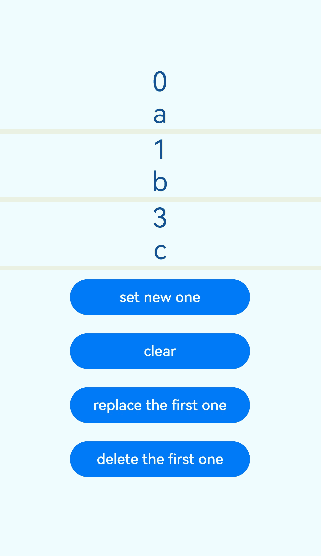
Extended Set Class
NOTE
Since API version 11, \@ObjectLink supports @Observed decorated classes extending from Set and the Set type.
In the following example, the mySet variable is of the MySet<number> type. When the button is clicked, the value of mySet changes, and the UI is re-rendered.
@Observed
class Info {
public info: MySet<number>;
constructor(info: MySet<number>) {
this.info = info;
}
}
@Observed
export class MySet<T> extends Set<T> {
public name: string;
constructor(name?: string, args?: T[]) {
super(args);
this.name = name ? name : "My Set";
}
getName() {
return this.name;
}
}
@Entry
@Component
struct SetSampleNested {
@State message: Info = new Info(new MySet("Set", [0, 1, 2, 3, 4]));
build() {
Row() {
Column() {
SetSampleNestedChild({ mySet: this.message.info })
}
.width('100%')
}
.height('100%')
}
}
@Component
struct SetSampleNestedChild {
@ObjectLink mySet: MySet<number>;
build() {
Row() {
Column() {
ForEach(Array.from(this.mySet.entries()), (item: [number, number]) => {
Text(`${item}`).fontSize(30)
Divider()
})
Button('set new one')
.width(200)
.margin(10)
.onClick(() => {
this.mySet.add(5);
})
Button('clear')
.width(200)
.margin(10)
.onClick(() => {
this.mySet.clear();
})
Button('delete the first one')
.width(200)
.margin(10)
.onClick(() => {
this.mySet.delete(0);
})
}
.width('100%')
}
.height('100%')
}
}
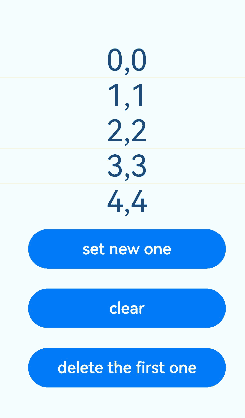
Union Type @ObjectLink
@ObjectLink supports union types of @Observed decorated classes and undefined or null. In the following example, the type of count is Source|Data|undefined. If the property or type of count is changed when the button in the Parent component is clicked, the change will be synchronized to the Child component.
@Observed
class Source {
public source: number;
constructor(source: number) {
this.source = source;
}
}
@Observed
class Data {
public data: number;
constructor(data: number) {
this.data = data;
}
}
@Entry
@Component
struct Parent {
@State count: Source|Data|undefined = new Source(10);
build() {
Column() {
Child({ count: this.count })
Button('change count property')
.margin(10)
.onClick(() => {
// Determine the count type and update the property.
if (this.count instanceof Source) {
this.count.source += 1;
} else if (this.count instanceof Data) {
this.count.data += 1;
} else {
console.info('count is undefined, cannot change property');
}
})
Button('change count to Source')
.margin(10)
.onClick(() => {
// Assign the value of an instance of Source.
this.count = new Source(100);
})
Button('change count to Data')
.margin(10)
.onClick(() => {
// Assign the value of an instance of Data.
this.count = new Data(100);
})
Button('change count to undefined')
.margin(10)
.onClick(() => {
// Assign the value undefined.
this.count = undefined;
})
}.width('100%')
}
}
@Component
struct Child {
@ObjectLink count: Source|Data|undefined;
build() {
Column() {
Text(`count is instanceof ${this.count instanceof Source ? 'Source' :
this.count instanceof Data ? 'Data' : 'undefined'}`)
.fontSize(30)
.margin(10)
Text(`count's property is ${this.count instanceof Source ? this.count.source : this.count?.data}`).fontSize(15)
}.width('100%')
}
}
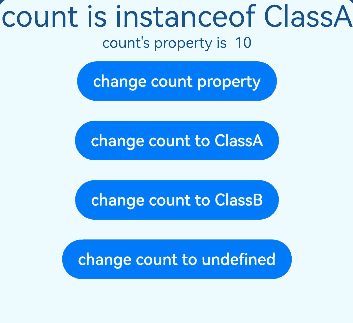
FAQs
Assigning Value to @ObjectLink Decorated Variable in Child Component
It is not allowed to assign a value to an @ObjectLink decorated variable in the child component.
[Incorrect Usage]
@Observed
class Info {
public info: number = 0;
constructor(info: number) {
this.info = info;
}
}
@Component
struct ObjectLinkChild {
@ObjectLink testNum: Info;
build() {
Text(`ObjectLinkChild testNum ${this.testNum.info}`)
.onClick(() => {
// The @ObjectLink decorated variable cannot be assigned a value here.
this.testNum = new Info(47);
})
}
}
@Entry
@Component
struct Parent {
@State testNum: Info[] = [new Info(1)];
build() {
Column() {
Text(`Parent testNum ${this.testNum[0].info}`)
.onClick(() => {
this.testNum[0].info += 1;
})
ObjectLinkChild({ testNum: this.testNum[0] })
}
}
}
In this example, an attempt is made to assign a value to the @ObjectLink decorated variable by clicking ObjectLinkChild.
this.testNum = new Info(47);
This is not allowed. For @ObjectLink that implements two-way data synchronization, assigning a value is equivalent to updating the array item or class property in the parent component, which is not supported in TypeScript/JavaScript and will result in a runtime error.
[Correct Usage]
@Observed
class Info {
public info: number = 0;
constructor(info: number) {
this.info = info;
}
}
@Component
struct ObjectLinkChild {
@ObjectLink testNum: Info;
build() {
Text(`ObjectLinkChild testNum ${this.testNum.info}`)
.onClick(() => {
// You can assign values to the properties of the ObjectLink decorated object.
this.testNum.info = 47;
})
}
}
@Entry
@Component
struct Parent {
@State testNum: Info[] = [new Info(1)];
build() {
Column() {
Text(`Parent testNum ${this.testNum[0].info}`)
.onClick(() => {
this.testNum[0].info += 1;
})
ObjectLinkChild({ testNum: this.testNum[0] })
}
}
}
UI Not Updated on property Changes in Simple Nested Objects
If you find your application UI not updating after a property in a nested object is changed, you may want to check the decorators in use.
Each decorator has its scope of observable changes, and only those observed changes can cause the UI to update. The \@Observed decorator can observe the property changes of nested objects, while other decorators can observe only the changes at the first layer.
[Incorrect Usage]
In the following example, some UI components are not updated.
class Parent {
parentId: number;
constructor(parentId: number) {
this.parentId = parentId;
}
getParentId(): number {
return this.parentId;
}
setParentId(parentId: number): void {
this.parentId = parentId;
}
}
class Child {
childId: number;
constructor(childId: number) {
this.childId = childId;
}
getChildId(): number {
return this.childId;
}
setChildId(childId: number): void {
this.childId = childId;
}
}
class Cousin extends Parent {
cousinId: number = 47;
child: Child;
constructor(parentId: number, cousinId: number, childId: number) {
super(parentId);
this.cousinId = cousinId;
this.child = new Child(childId);
}
getCousinId(): number {
return this.cousinId;
}
setCousinId(cousinId: number): void {
this.cousinId = cousinId;
}
getChild(): number {
return this.child.getChildId();
}
setChild(childId: number): void {
return this.child.setChildId(childId);
}
}
@Entry
@Component
struct MyView {
@State cousin: Cousin = new Cousin(10, 20, 30);
build() {
Column({ space: 10 }) {
Text(`parentId: ${this.cousin.parentId}`)
Button("Change Parent.parent")
.onClick(() => {
this.cousin.parentId += 1;
})
Text(`cousinId: ${this.cousin.cousinId}`)
Button("Change Cousin.cousinId")
.onClick(() => {
this.cousin.cousinId += 1;
})
Text(`childId: ${this.cousin.child.childId}`)
Button("Change Cousin.Child.childId")
.onClick(() => {
// The Text component is not updated when clicked.
this.cousin.child.childId += 1;
})
}
}
}
The UI is not re-rendered when the last Text(‘child: ${this.cousin.child.childId}’) is clicked. This is because, \@State cousin: Cousin can only observe the property change of this.cousin, such as this.cousin.parentId, this.cousin.cousinId, and this.cousin.child, but cannot observe the in-depth property, that is, this.cousin.child.childId (childId is the property of the Child object embedded in cousin).
To observe the properties of nested object Child, you need to make the following changes:
- Construct a child component for separate rendering of the Child instance. This child component can use \@ObjectLink child : Child or \@Prop child : Child. \@ObjectLink is generally used, unless local changes to the Child object are required.
- The nested Child object must be decorated by \@Observed. When a Child object is created in Cousin (Cousin(10, 20, 30) in this example), it is wrapped in the ES6 proxy. When the Child property changes to this.cousin.child.childId += 1, the \@ObjectLink decorated variable is notified of the change.
[Correct Usage]
The following example uses \@Observed/\@ObjectLink to observe property changes for nested objects.
class Parent {
parentId: number;
constructor(parentId: number) {
this.parentId = parentId;
}
getParentId(): number {
return this.parentId;
}
setParentId(parentId: number): void {
this.parentId = parentId;
}
}
@Observed
class Child {
childId: number;
constructor(childId: number) {
this.childId = childId;
}
getChildId(): number {
return this.childId;
}
setChildId(childId: number): void {
this.childId = childId;
}
}
class Cousin extends Parent {
cousinId: number = 47;
child: Child;
constructor(parentId: number, cousinId: number, childId: number) {
super(parentId);
this.cousinId = cousinId;
this.child = new Child(childId);
}
getCousinId(): number {
return this.cousinId;
}
setCousinId(cousinId: number): void {
this.cousinId = cousinId;
}
getChild(): number {
return this.child.getChildId();
}
setChild(childId: number): void {
return this.child.setChildId(childId);
}
}
@Component
struct ViewChild {
@ObjectLink child: Child;
build() {
Column({ space: 10 }) {
Text(`childId: ${this.child.getChildId()}`)
Button("Change childId")
.onClick(() => {
this.child.setChildId(this.child.getChildId() + 1);
})
}
}
}
@Entry
@Component
struct MyView {
@State cousin: Cousin = new Cousin(10, 20, 30);
build() {
Column({ space: 10 }) {
Text(`parentId: ${this.cousin.parentId}`)
Button("Change Parent.parentId")
.onClick(() => {
this.cousin.parentId += 1;
})
Text(`cousinId: ${this.cousin.cousinId}`)
Button("Change Cousin.cousinId")
.onClick(() => {
this.cousin.cousinId += 1;
})
ViewChild({ child: this.cousin.child }) // Alternative format of Text(`childId: ${this.cousin.child.childId}`).
Button("Change Cousin.Child.childId")
.onClick(() => {
this.cousin.child.childId += 1;
})
}
}
}
UI Not Updated on property Changes in Complex Nested Objects
[Incorrect Usage]
The following example creates a child component with an \@ObjectLink decorated variable to render ParentCounter with nested properties. Specifically, SubCounter nested in ParentCounter is decorated with \@Observed.
let nextId = 1;
@Observed
class SubCounter {
counter: number;
constructor(c: number) {
this.counter = c;
}
}
@Observed
class ParentCounter {
id: number;
counter: number;
subCounter: SubCounter;
incrCounter() {
this.counter++;
}
incrSubCounter(c: number) {
this.subCounter.counter += c;
}
setSubCounter(c: number): void {
this.subCounter.counter = c;
}
constructor(c: number) {
this.id = nextId++;
this.counter = c;
this.subCounter = new SubCounter(c);
}
}
@Component
struct CounterComp {
@ObjectLink value: ParentCounter;
build() {
Column({ space: 10 }) {
Text(`${this.value.counter}`)
.fontSize(25)
.onClick(() => {
this.value.incrCounter();
})
Text(`${this.value.subCounter.counter}`)
.onClick(() => {
this.value.incrSubCounter(1);
})
Divider().height(2)
}
}
}
@Entry
@Component
struct ParentComp {
@State counter: ParentCounter[] = [new ParentCounter(1), new ParentCounter(2), new ParentCounter(3)];
build() {
Row() {
Column() {
CounterComp({ value: this.counter[0] })
CounterComp({ value: this.counter[1] })
CounterComp({ value: this.counter[2] })
Divider().height(5)
ForEach(this.counter,
(item: ParentCounter) => {
CounterComp({ value: item })
},
(item: ParentCounter) => item.id.toString()
)
Divider().height(5)
// First click event
Text('Parent: incr counter[0].counter')
.fontSize(20).height(50)
.onClick(() => {
this.counter[0].incrCounter();
// The value increases by 10 each time the event is triggered.
this.counter[0].incrSubCounter(10);
})
// Second click event
Text('Parent: set.counter to 10')
.fontSize(20).height(50)
.onClick(() => {
// The value cannot be set to 10, and the UI is not updated.
this.counter[0].setSubCounter(10);
})
Text('Parent: reset entire counter')
.fontSize(20).height(50)
.onClick(() => {
this.counter = [new ParentCounter(1), new ParentCounter(2), new ParentCounter(3)];
})
}
}
}
}
For the onClick event of Text(‘Parent: incr counter[0].counter’), this.counter[0].incrSubCounter(10) calls the incrSubCounter method to increase the counter value of SubCounter by 10. The UI is updated to reflect the change.
However, when this.counter[0].setSubCounter(10) is called in onClick of Text(‘Parent: set.counter to 10’), the counter value of SubCounter cannot be reset to 10.
incrSubCounter and setSubCounter are functions of the same SubCounter. The UI can be correctly updated when incrSubCounter is called for the first click event. However, the UI is not updated when setSubCounter is called for the second click event. Actually neither incrSubCounter nor setSubCounter can trigger an update of Text(‘${this.value.subCounter.counter}’). This is because \@ObjectLink value: ParentCounter can only observe the properties of ParentCounter. this.value.subCounter.counter is a property of SubCounter and therefore cannot be observed.
However, when this.counter[0].incrCounter() is called for the first click event, it marks \@ObjectLink value: ParentCounter in the CounterComp component as changed. In this case, an update of Text(‘${this.value.subCounter.counter}’) is triggered. If this.counter[0].incrCounter() is deleted from the first click event, the UI cannot be updated.
[Correct Usage]
To solve the preceding problem, you can use the following method to directly observe the properties in SubCounter so that the this.counter[0].setSubCounter(10) API works:
CounterComp({ value: this.counter[0] }); // ParentComp passes ParentCounter to CounterComp.
@ObjectLink value: ParentCounter; // @ObjectLink receives ParentCounter.
// CounterChild is a child component of CounterComp. CounterComp passes this.value.subCounter to the CounterChild component.
CounterChild({ subValue: this.value.subCounter });
@ObjectLink subValue: SubCounter; // @ObjectLink receives SubCounter.
This approach enables \@ObjectLink to serve as a proxy for the properties of the ParentCounter and SubCounter classes. In this way, the property changes of the two classes can be observed and trigger UI update. Even if this.counter[0].incrCounter() is deleted, the UI can be updated correctly.
This approach can be used to implement “two-layer” observation, that is, observation of external objects and internal nested objects. However, it is only applicable to the \@ObjectLink decorator, but not to \@Prop (\@Prop passes objects through deep copy). For details, see Differences Between \@Prop and \@ObjectLink.
let nextId = 1;
@Observed
class SubCounter {
counter: number;
constructor(c: number) {
this.counter = c;
}
}
@Observed
class ParentCounter {
id: number;
counter: number;
subCounter: SubCounter;
incrCounter() {
this.counter++;
}
incrSubCounter(c: number) {
this.subCounter.counter += c;
}
setSubCounter(c: number): void {
this.subCounter.counter = c;
}
constructor(c: number) {
this.id = nextId++;
this.counter = c;
this.subCounter = new SubCounter(c);
}
}
@Component
struct CounterComp {
@ObjectLink value: ParentCounter;
build() {
Column({ space: 10 }) {
Text(`${this.value.counter}`)
.fontSize(25)
.onClick(() => {
this.value.incrCounter();
})
CounterChild({ subValue: this.value.subCounter })
Divider().height(2)
}
}
}
@Component
struct CounterChild {
@ObjectLink subValue: SubCounter;
build() {
Text(`${this.subValue.counter}`)
.onClick(() => {
this.subValue.counter += 1;
})
}
}
@Entry
@Component
struct ParentComp {
@State counter: ParentCounter[] = [new ParentCounter(1), new ParentCounter(2), new ParentCounter(3)];
build() {
Row() {
Column() {
CounterComp({ value: this.counter[0] })
CounterComp({ value: this.counter[1] })
CounterComp({ value: this.counter[2] })
Divider().height(5)
ForEach(this.counter,
(item: ParentCounter) => {
CounterComp({ value: item })
},
(item: ParentCounter) => item.id.toString()
)
Divider().height(5)
Text('Parent: reset entire counter')
.fontSize(20).height(50)
.onClick(() => {
this.counter = [new ParentCounter(1), new ParentCounter(2), new ParentCounter(3)];
})
Text('Parent: incr counter[0].counter')
.fontSize(20).height(50)
.onClick(() => {
this.counter[0].incrCounter();
this.counter[0].incrSubCounter(10);
})
Text('Parent: set.counter to 10')
.fontSize(20).height(50)
.onClick(() => {
this.counter[0].setSubCounter(10);
})
}
}
}
}
Differences Between \@Prop and \@ObjectLink
In the following example, the \@ObjectLink decorated variable is a reference to the data source. That is, this.value.subCounter and this.subValue are different references to the same object. Therefore, when the click handler of CounterComp is clicked, both this.value.subCounter.counter and this.subValue.counter change, and the corresponding component Text(this.subValue.counter: ${this.subValue.counter}) is re-rendered.
let nextId = 1;
@Observed
class SubCounter {
counter: number;
constructor(c: number) {
this.counter = c;
}
}
@Observed
class ParentCounter {
id: number;
counter: number;
subCounter: SubCounter;
incrCounter() {
this.counter++;
}
incrSubCounter(c: number) {
this.subCounter.counter += c;
}
setSubCounter(c: number): void {
this.subCounter.counter = c;
}
constructor(c: number) {
this.id = nextId++;
this.counter = c;
this.subCounter = new SubCounter(c);
}
}
@Component
struct CounterComp {
@ObjectLink value: ParentCounter;
build() {
Column({ space: 10 }) {
CountChild({ subValue: this.value.subCounter })
Text(`this.value.counter: increase 7 `)
.fontSize(30)
.onClick(() => {
// Text(`this.subValue.counter: ${this.subValue.counter}`) is re-rendered after clicking.
this.value.incrSubCounter(7);
})
Divider().height(2)
}
}
}
@Component
struct CountChild {
@ObjectLink subValue: SubCounter;
build() {
Text(`this.subValue.counter: ${this.subValue.counter}`)
.fontSize(30)
}
}
@Entry
@Component
struct ParentComp {
@State counter: ParentCounter[] = [new ParentCounter(1), new ParentCounter(2), new ParentCounter(3)];
build() {
Row() {
Column() {
CounterComp({ value: this.counter[0] })
CounterComp({ value: this.counter[1] })
CounterComp({ value: this.counter[2] })
Divider().height(5)
ForEach(this.counter,
(item: ParentCounter) => {
CounterComp({ value: item })
},
(item: ParentCounter) => item.id.toString()
)
Divider().height(5)
Text('Parent: reset entire counter')
.fontSize(20).height(50)
.onClick(() => {
this.counter = [new ParentCounter(1), new ParentCounter(2), new ParentCounter(3)];
})
Text('Parent: incr counter[0].counter')
.fontSize(20).height(50)
.onClick(() => {
this.counter[0].incrCounter();
this.counter[0].incrSubCounter(10);
})
Text('Parent: set.counter to 10')
.fontSize(20).height(50)
.onClick(() => {
this.counter[0].setSubCounter(10);
})
}
}
}
}
The following figure shows how \@ObjectLink works.
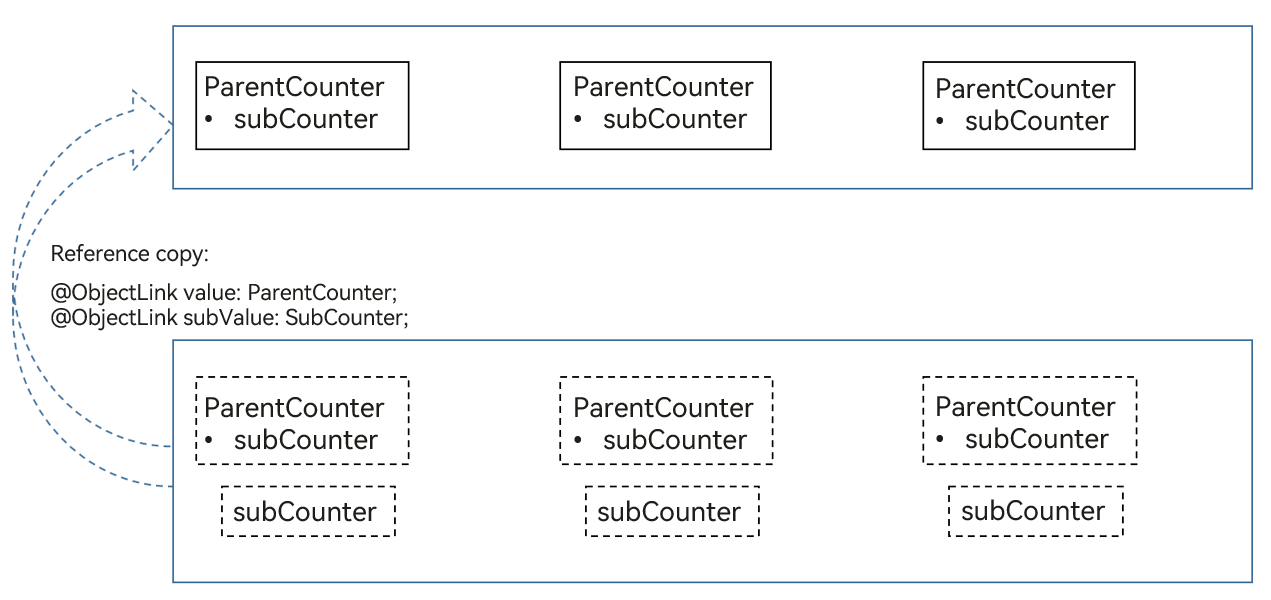
[Incorrect Usage]
\@Prop is used instead of \@ObjectLink. Click Text(this.subValue.counter: ${this.subValue.counter}), and the UI is re-rendered properly. However, when you click Text(this.value.counter: increase 7), \@Prop makes a local copy of the variable, and the first Text of CounterComp is not re-rendered.
this.value.subCounter and this.subValue are not the same object. Therefore, the change of this.value.subCounter does not change the copy object of this.subValue, and Text(this.subValue.counter: ${this.subValue.counter}) is not re-rendered.
@Component
struct CounterComp {
@Prop value: ParentCounter = new ParentCounter(0);
@Prop subValue: SubCounter = new SubCounter(0);
build() {
Column({ space: 10 }) {
Text(`this.subValue.counter: ${this.subValue.counter}`)
.fontSize(20)
.onClick(() => {
this.subValue.counter += 7;
})
Text(`this.value.counter: increase 7 `)
.fontSize(20)
.onClick(() => {
this.value.incrSubCounter(7);
})
Divider().height(2)
}
}
}
The following figure shows how \@Prop works.
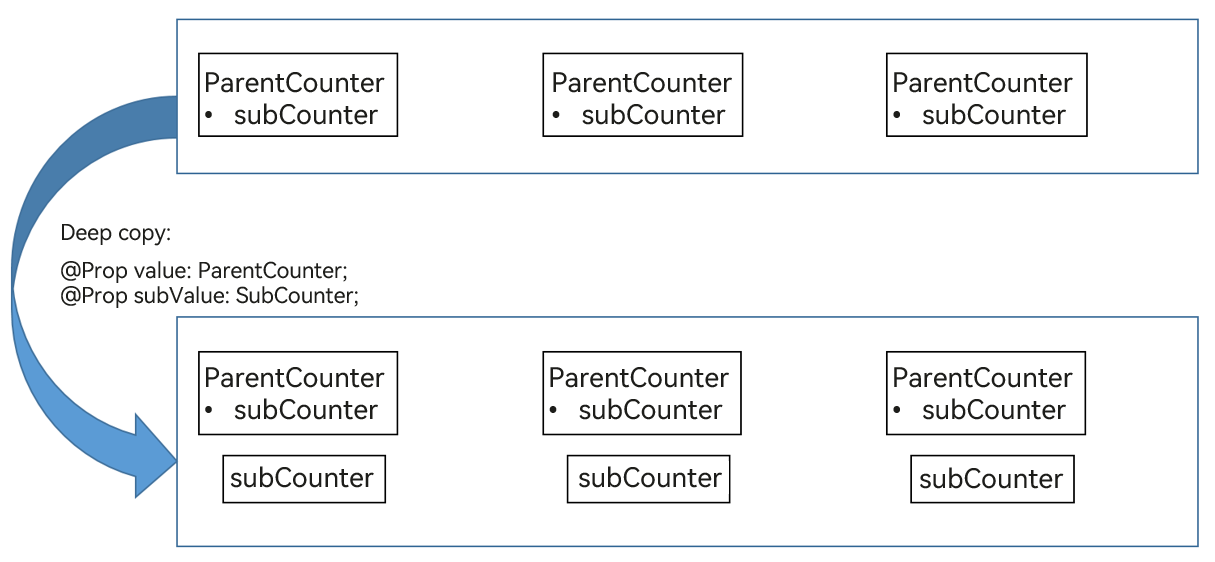
[Correct Usage]
Make only one copy of \@Prop value: ParentCounter from ParentComp to CounterComp. Do not make another copy of SubCounter.
Use only one \@Prop counter: Counter in the CounterComp component.
Add another child component SubCounterComp that contains \@ObjectLink subCounter: SubCounter. This \@ObjectLink ensures that changes to the SubCounter object properties are observed and the UI is updated properly.
\@ObjectLink subCounter: SubCounter shares the same SubCounter object with this.counter.subCounter of \@Prop counter: Counter in CounterComp.
let nextId = 1;
@Observed
class SubCounter {
counter: number;
constructor(c: number) {
this.counter = c;
}
}
@Observed
class ParentCounter {
id: number;
counter: number;
subCounter: SubCounter;
incrCounter() {
this.counter++;
}
incrSubCounter(c: number) {
this.subCounter.counter += c;
}
setSubCounter(c: number): void {
this.subCounter.counter = c;
}
constructor(c: number) {
this.id = nextId++;
this.counter = c;
this.subCounter = new SubCounter(c);
}
}
@Component
struct SubCounterComp {
@ObjectLink subValue: SubCounter;
build() {
Text(`SubCounterComp: this.subValue.counter: ${this.subValue.counter}`)
.onClick(() => {
this.subValue.counter = 7;
})
}
}
@Component
struct CounterComp {
@Prop value: ParentCounter;
build() {
Column({ space: 10 }) {
Text(`this.value.incrCounter(): this.value.counter: ${this.value.counter}`)
.fontSize(20)
.onClick(() => {
this.value.incrCounter();
})
SubCounterComp({ subValue: this.value.subCounter })
Text(`this.value.incrSubCounter()`)
.onClick(() => {
this.value.incrSubCounter(77);
})
Divider().height(2)
}
}
}
@Entry
@Component
struct ParentComp {
@State counter: ParentCounter[] = [new ParentCounter(1), new ParentCounter(2), new ParentCounter(3)];
build() {
Row() {
Column() {
CounterComp({ value: this.counter[0] })
CounterComp({ value: this.counter[1] })
CounterComp({ value: this.counter[2] })
Divider().height(5)
ForEach(this.counter,
(item: ParentCounter) => {
CounterComp({ value: item })
},
(item: ParentCounter) => item.id.toString()
)
Divider().height(5)
Text('Parent: reset entire counter')
.fontSize(20).height(50)
.onClick(() => {
this.counter = [new ParentCounter(1), new ParentCounter(2), new ParentCounter(3)];
})
Text('Parent: incr counter[0].counter')
.fontSize(20).height(50)
.onClick(() => {
this.counter[0].incrCounter();
this.counter[0].incrSubCounter(10);
})
Text('Parent: set.counter to 10')
.fontSize(20).height(50)
.onClick(() => {
this.counter[0].setSubCounter(10);
})
}
}
}
}
The following figure shows the copy relationship.
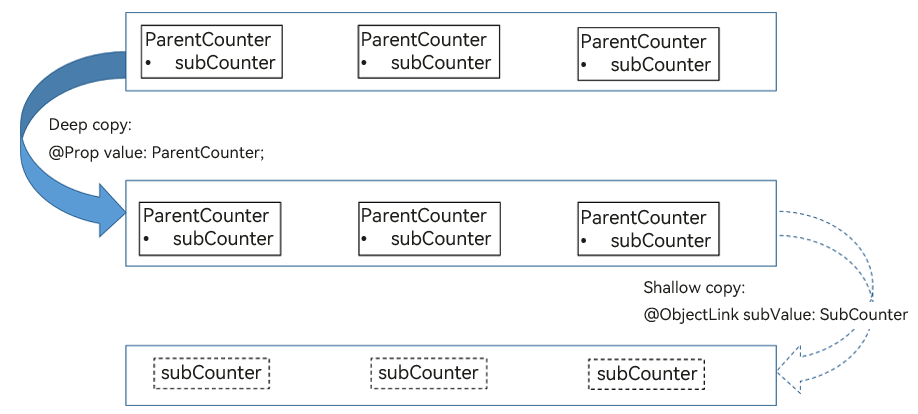
Member Variable Changes in the @Observed Decorated Class Constructor Not Taking Effect
In state management, @Observed decorated classes are wrapped with a proxy. When a member variable of a class is changed in a component, the proxy intercepts the change. When the value in the data source is changed, the proxy notifies the bound component of the change. In this way, the change can be observed and trigger UI re-rendering.
If the value change of a member variable occurs in the class constructor, the change does not pass through the proxy (because the change occurs in the data source). Therefore, even if the change is successful with a timer in the class constructor, the UI cannot be re-rendered.
[Incorrect Usage]
@Observed
class RenderClass {
waitToRender: boolean = false;
constructor() {
setTimeout(() => {
this.waitToRender = true;
console.log("Change the value of waitToRender to" + this.waitToRender);
}, 1000)
}
}
@Entry
@Component
struct Index {
@State @Watch('renderClassChange') renderClass: RenderClass = new RenderClass();
@State textColor: Color = Color.Black;
renderClassChange() {
console.log("The value of renderClass is changed to" + this.renderClass.waitToRender);
}
build() {
Row() {
Column() {
Text("The value of renderClass is" + this.renderClass.waitToRender)
.fontSize(20)
.fontColor(this.textColor)
Button("Show")
.onClick(() => {
// It is not recommended to use other state variables to forcibly re-render the UI. This example is used to check whether the value of waitToRender is updated.
this.textColor = Color.Red;
})
}
.width('100%')
}
.height('100%')
}
}
In the preceding example, a timer is used in the constructor of RenderClass. Though the value of waitToRender changes 1 second later, the UI is not re-rendered. After the button is clicked to forcibly refresh the Text component, you can see that the value of waitToRender is changed to true.
[Correct Usage]
@Observed
class RenderClass {
waitToRender: boolean = false;
constructor() {
}
}
@Entry
@Component
struct Index {
@State @Watch('renderClassChange') renderClass: RenderClass = new RenderClass();
renderClassChange() {
console.log("The value of renderClass is changed to" + this.renderClass.waitToRender);
}
onPageShow() {
setTimeout(() => {
this.renderClass.waitToRender = true;
console.log("Change the value of renderClass to" + this.renderClass.waitToRender);
}, 1000)
}
build() {
Row() {
Column() {
Text("The value of renderClass is" + this.renderClass.waitToRender)
.fontSize(20)
}
.width('100%')
}
.height('100%')
}
}
In the preceding example, the timer is moved to the component. In this case, the page displays “The value of renderClass is changed to false”. When the timer is triggered, the value of renderClass is changed, triggering the @Watch callback. As a result, page content changes to “The value of renderClass is true” and the log is displayed as “Change the value of renderClass to true”.
In sum, it is recommended that you change the class members decorated by @Observed in components to implement UI re-rendering.
\@ObjectLink Data Source Update Timing
@Observed
class Person {
name: string = '';
age: number = 0;
constructor(name: string, age: number) {
this.name = name;
this.age = age;
}
}
@Observed
class Info {
person: Person;
constructor(person: Person) {
this.person = person;
}
}
@Entry
@Component
struct Parent {
@State @Watch('onChange01') info: Info = new Info(new Person('Bob', 10));
onChange01() {
console.log(':::onChange01:' + this.info.person.name); // 2
}
build() {
Column() {
Text(this.info.person.name).height(40)
Child({
per: this.info.person, clickEvent: () => {
console.log(':::clickEvent before', this.info.person.name); // 1
this.info.person = new Person('Jack', 12);
console.log(':::clickEvent after', this.info.person.name); // 3
}
})
}
}
}
@Component
struct Child {
@ObjectLink @Watch('onChange02') per: Person;
clickEvent?: () => void;
onChange02() {
console.log(':::onChange02:' + this.per.name); // 5
}
build() {
Column() {
Button(this.per.name)
.height(40)
.onClick(() => {
this.onClickType();
})
}
}
private onClickType() {
if (this.clickEvent) {
this.clickEvent();
}
console.log(':::-------- this.per.name in Child is still:' + this.per.name); // 4
}
}
The data source update of \@ObjectLink depends on its parent component. When the data source changes of the parent component trigger a re-rendering on the parent component, the data source of the child component \@ObjectLink is reset. This process does not occur immediately after the data source of the parent component changes. Instead, it occurs when the parent component is re-rendered. In the preceding example, Parent contains Child and passes the arrow function to Child. When the child component is clicked, the log printing sequence is from 1 to 5. When the log is printed to log 4, the click event process ends. In this case, only Child is marked as the node that needs to be updated by the parent component, therefore, the value of this.per.name in log 4 is still Bob. The data source of Child is updated only when the parent component is re-rendered.
When the \@Watch function of @ObjectLink @Watch(‘onChange02’) per: Person is executed, the data source of \@ObjectLink has been updated by the parent component. In this case, the value printed in log 5 is Jack.
The meaning of the log is as follows: - Log 1: Before a value is assigned to Parent @State @Watch(‘onChange01’) info: Info = new Info(new Person(‘Bob’, 10)).
Log 2: Assign a value to Parent @State @Watch(‘onChange01’) info: Info = new Info(new Person(‘Bob’, 10)) and execute its \@Watch function synchronously.
Log 3: A value is assigned to Parent @State @Watch(‘onChange01’) info: Info = new Info(new Person(‘Bob’, 10)).
Log 4: After clickEvent in the onClickType method is executed, Child is marked as the node that needs to be updated by the parent component, and the latest value is not updated to Child @ObjectLink @Watch(‘onChange02’) per: Person. Therefore, the value of this.per.name in log 4 is still Bob.
Log 5: The next VSync triggers Child re-rendering. @ObjectLink @Watch(‘onChange02’) per: Person is re-rendered and its @Watch method is triggered. In this case, the new value of the @ObjectLink @Watch(‘onChange02’) per: Person is Jack.
The parent-child synchronization principle of \@Prop is the same as that of \@ObjectLink.
When this.info.person.name is changed in clickEvent, this change takes effect immediately. In this case, the value of log 4 is Jack.
Child({
per: this.info.person, clickEvent: () => {
console.log(':::clickEvent before', this.info.person.name); // 1
this.info.person.name = 'Jack';
console.log(':::clickEvent after', this.info.person.name); // 3
}
})
The Text component in Parent is not re-rendered because this.info.person.name is a value with two-layer nesting.
Using the a.b(this.object) Format Fails to Trigger UI Re-render
In the build method, when the variable decorated by @Observed and @ObjectLink is of the object type and is called using the a.b(this.object) format, the original object of this.object is passed in the b method. If the property of this.object is changed, the UI cannot be re-rendered. In the following example, the UI re-render is not triggered when this.weather.temperature in the component is changed by using a static method or using this to call the internal method of the component.
[Incorrect Usage]
@Observed
class Weather {
temperature:number;
constructor(temperature:number) {
this.temperature = temperature;
}
static increaseTemperature(weather:Weather) {
weather.temperature++;
}
}
class Day {
weather:Weather;
week:string;
constructor(weather:Weather, week:string) {
this.weather = weather;
this.week = week;
}
}
@Entry
@Component
struct Parent {
@State day1: Day = new Day(new Weather(15), 'Monday');
build() {
Column({ space:10 }) {
Child({ weather: this.day1.weather})
}
.height('100%')
.width('100%')
}
}
@Component
struct Child {
@ObjectLink weather: Weather;
reduceTemperature (weather:Weather) {
weather.temperature--;
}
build() {
Column({ space:10 }) {
Text(`The temperature of day1 is ${this.weather.temperature} degrees.`)
.fontSize(20)
Button('increaseTemperature')
.onClick(()=>{
// The UI cannot be re-rendered using a static method.
Weather.increaseTemperature(this.weather);
})
Button('reduceTemperature')
.onClick(()=>{
// The UI cannot be re-rendered using this.
this.reduceTemperature(this.weather);
})
}
.height('100%')
.width('100%')
}
}
You can add a proxy for this.weather to re-render the UI by assigning a value to the variable and then calling the variable.
[Correct Usage]
@Observed
class Weather {
temperature:number;
constructor(temperature:number) {
this.temperature = temperature;
}
static increaseTemperature(weather:Weather) {
weather.temperature++;
}
}
class Day {
weather:Weather;
week:string;
constructor(weather:Weather, week:string) {
this.weather = weather;
this.week = week;
}
}
@Entry
@Component
struct Parent {
@State day1: Day = new Day(new Weather(15), 'Monday');
build() {
Column({ space:10 }) {
Child({ weather: this.day1.weather})
}
.height('100%')
.width('100%')
}
}
@Component
struct Child {
@ObjectLink weather: Weather;
reduceTemperature (weather:Weather) {
weather.temperature--;
}
build() {
Column({ space:10 }) {
Text(`The temperature of day1 is ${this.weather.temperature} degrees.`)
.fontSize(20)
Button('increaseTemperature')
.onClick(()=>{
// Add a proxy by assigning a value.
let weather1 = this.weather;
Weather.increaseTemperature(weather1);
})
Button('reduceTemperature')
.onClick(()=>{
// Add a proxy by assigning a value.
let weather2 = this.weather;
this.reduceTemperature(weather2);
})
}
.height('100%')
.width('100%')
}
}
你可能感兴趣的鸿蒙文章
harmony 鸿蒙\@AnimatableExtend Decorator: Definition of Animatable Attributes
harmony 鸿蒙Application State Management Overview
harmony 鸿蒙AppStorage: Storing Application-wide UI State
harmony 鸿蒙Basic Syntax Overview
harmony 鸿蒙\@Builder Decorator: Custom Builder Function
harmony 鸿蒙\@BuilderParam Decorator: Referencing the \@Builder Function
harmony 鸿蒙Creating a Custom Component
harmony 鸿蒙Mixing Use of Custom Components
harmony 鸿蒙Constraints on Access Modifiers of Custom Component Member Variables
- 所属分类: 后端技术
- 本文标签:
热门推荐
-
2、 - 优质文章
-
3、 gate.io
-
7、 openharmony
-
9、 golang